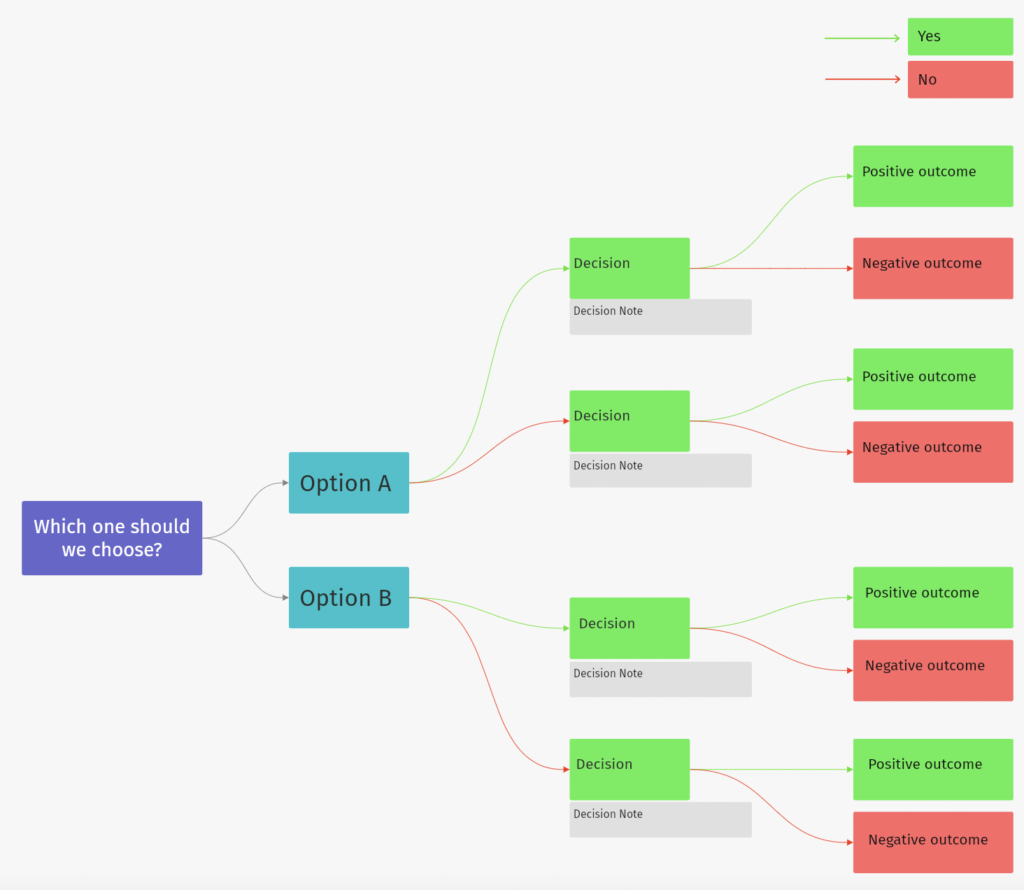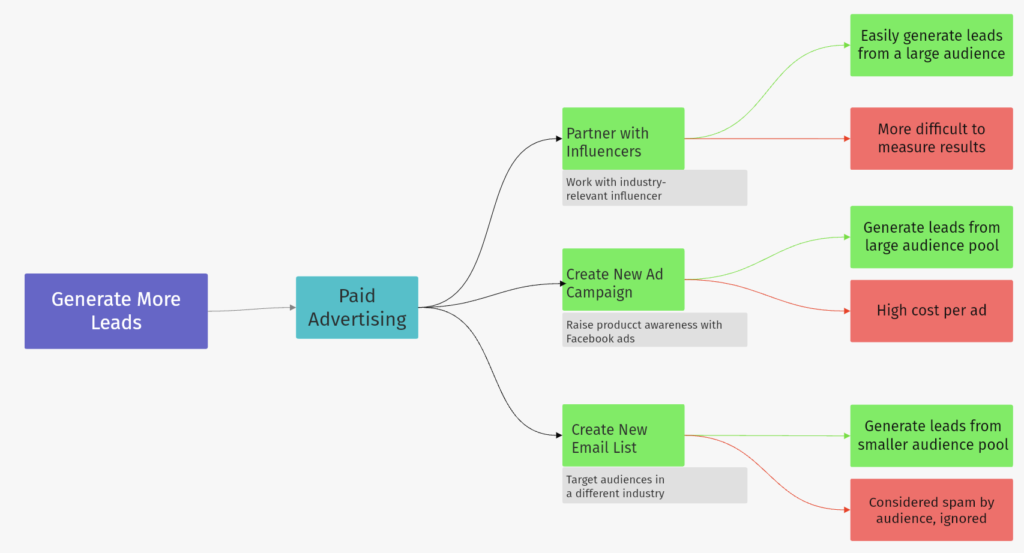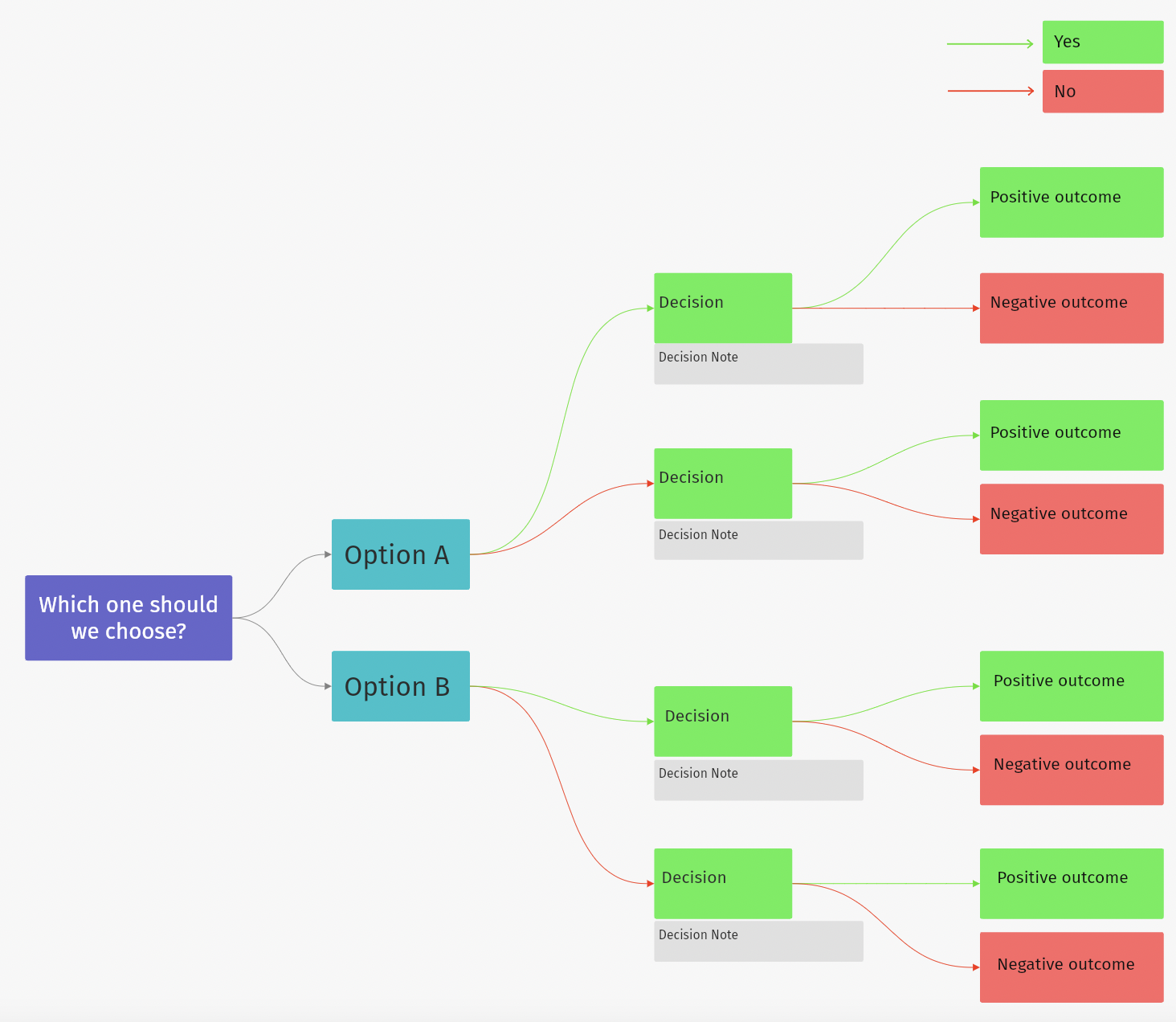In business, opportunity means the potential for gain. In other words, it’s when something positive happens and you can take advantage of it to make or save money. It could be anything from a new market opening up to a cost going down.
The opportunities in your business are everywhere; you just have to know where to look and be able to recognize them when they appear. That being said, the recognition process is not always easy. Most people don’t keep a list of potential opportunities and how likely they are to appear again in the future.
By identifying opportunities as they come up (or even imagining what might appear someday), you can keep track of them and also decide which ones are worth pursuing further. An Opportunity Solution Tree is one helpful way to do that.
What is an Opportunity Solution Tree?

An Opportunity Solution Tree is a visual way to keep track of opportunities, potential solutions to problems, and the results of possible solutions.
It helps you see connections among opportunities and solutions, thereby helping you to make better decisions. You can make an Opportunity Solution Tree for a particular opportunity or for a category of opportunities.
One way to make it for a particular opportunity is to start with your desired outcome. Then ask yourself: What’s needed to make this outcome happen? What’s getting in the way of this outcome happening? What experiments can you do to evaluate your outcomes?
All of this can lead you to a visual representation of the opportunity as a whole, as well as what’s needed to solve it.
What Is the Purpose of an Opportunity Solution Tree?

Like a decision tree, an Opportunity Solution Tree helps you visualize the different steps involved in an opportunity and the possible outcomes of each one. It can help you see links you might not have considered before and determine how one solution can lead to another opportunity.
The Opportunity Solution Tree works on the metaphorical framework of a tree and consists of four main components: Desired Outcome (the trunk), the Opportunities that extend from the latter (the roots), and Solutions that could meet the needs of the identified Opportunities (branches and leaves), and finally, any Experiments that can be used to validate the Solutions.
At this stage, you’re probably wondering how to actually use this framework. Let’s use the following situation as an example to make things more clear:
“I run a cafe, which is a completely customer-oriented business. But for the past few months, my business has been going down. The customers are not visiting as much as they used to. It’s been a while since I have had all-reserved seats in my cafe. What could be the problem here and what can I do about it?”
In such a situation, it’s ideal that you assess the pointers that fulfill customer satisfaction. To do so, you could use either surveys or interviews. This way, you can map things out and follow the best practices to make your business get back on track. We’ll talk about this more below.
How to Make an Opportunity Solution Tree

Start by making a list of opportunities you’ve noticed in the past. You might’ve created an Opportunity Solution Tree while you were at a conference and noticed potential partnerships. You also might’ve made one when you wanted to expand your marketing channels.
You can also make it for a challenge in your business you want to solve. It can be something like increasing your leads or sales, decreasing your costs, or making your business more sustainable.
Here are three steps to make an opportunity tree:
Step 1: Identify Your Desired Outcome

The first step in making an opportunity tree is to decide on your desired outcome. What do you want to happen? What problem do you want to solve? For example, you might want to generate more leads or reduce your cost per lead.
Next, ask yourself: What’s needed to make this happen? What’s getting in the way? This can lead you to a visual representation of the opportunity as a whole, as well as what’s needed to solve it.
In other words, define what your success looks like. Success is measured in terms of how a product or service improves the lives of its end users, whether they’re individual consumers or large corporations. Perhaps there are certain patterns of conduct or areas of discomfort that need addressing. You may use any indicator that can show development toward your goal. The most important thing is that everyone in the team is on the same page about the final objective.
It’s also worth noting that even if your team is interested in pursuing many goals simultaneously, you’ll need to ensure that everyone’s voices are heard.
Step 2: Identify Opportunities

After you’ve identified your desired outcome, start to look for opportunities that could help you get there. What are your customers’ biggest challenges? What are the current pain points? What have they asked you about recently? What do you know about your industry that might be helpful?
If you have a particular challenge in mind, start by looking for the biggest contributors to that problem. For example, if the challenge of your business is that you have too few leads, then look at the biggest contributors to that problem. Once you identify that, start looking for possible solutions.
Step 3: Generate Solutions

At this stage, you’ve identified challenges and outcomes. Now comes the fun part: solution mapping and brainstorming. This can be done both by the team members as well as by people outside the team. As soon as a new idea occurs, you can jot it down and connect it to the opportunity it can relate to. If you can’t connect a solution to an opportunity, you can articulate a new opportunity, or discard the old solution altogether.
After the ideas are put into the solution tree, the team can once again engage in a comparative analysis to establish which ideas for a solution are the most promising. Dot voting or a similar system might be used.
Step 4: Experiment

After you’ve identified opportunities and solutions, experiment with them. Try out a few different solutions and see what happens. For example, if you want to generate more leads, you might try a few different types of paid advertising to see which works best. Or if you want to reduce your cost per lead, you might try a few different versions of your landing pages.
Keep track of the results of the experiments. Then use those results to help decide what to do next: Which solutions worked the best? Which ones were close, but not quite as good? Which ones didn’t work as well? Based on the results, you can decide which opportunities you want to pursue next.
Opportunity Solution Tree Example

Let’s go back to the example of the marketer looking for ways to generate leads. Here’s an example of how they might use an opportunity tree to decide which opportunities to pursue.
Their desired outcome is to generate more leads. To make that happen, they need to make potential customers more aware of their product, understand how it solves their problems, and be able to easily find it. What’s getting in the way of that outcome is a lack of awareness and confusion. If they achieved that outcome, it would help with the problem of not having enough leads. They could partner with influencers who are also their target customers with a large following. This way, their product has a better chance of being discovered by their customers.
Get the Most Out of Your Opportunity Solution Tree With Vibe

Opportunity Solution Trees seem simple in theory and easy to use in practice. However, many teams are unable to get started since there are too many minute elements to do right.
With a Vibe Board, creating Opportunity Solution Trees is easier than ever. Teams can use Vibe’s pre-built Canvas templates to jump right into problem-solving. With everything automatically saved in the cloud, teams can save and share their findings with everyone involved—and anyone can access these notes from anywhere, on any device. This way, when an idea strikes and you don’t have access to your office, you can still add to your Opportunity Solution Tree and never lose that thought. Vibe makes working through the Outcome, Opportunity, Solution, and Experiment chain a breeze.
{{< blog/cta-download-new content=”S1 Product Brochure” extra=”false” pdf=”https://vibe.us/pdf/s1-product-brochures/?utm_campaign=opportunity-solution-tree-overview&utm_medium=blog&utm_source=blog“>}}
FAQs
- How do you use an opportunity tree?
The Opportunity Solution Tree is a visual aid that uses the metaphor of a tree as an organizational framework. It can be used to identify opportunities and plan for desired outcomes. Using the Opportunity Solution Tree, you can discuss and document ideas, write questions that pertain to the branches of your tree, and have team members react and reflect using the tree to record collective understanding.
- Can anybody make an opportunity solution tree?
Yes! Opportunity Solution Trees can be made with or without the use of a template and for any kind of team.
It’s a visual representation of the team’s efforts, including their objectives, opportunities, proposed solutions, and ongoing experiments. With a Vibe Board on hand, making Opportunity Solution Trees is even easier, with an easy whiteboarding experience and pre-built templates.
- What is opportunity mapping?
Opportunity mapping is a method of analysis that helps us learn more about the “opportunity” dynamics of certain areas. Opportunity maps can be created by comparing which areas have more and which have fewer opportunities.
